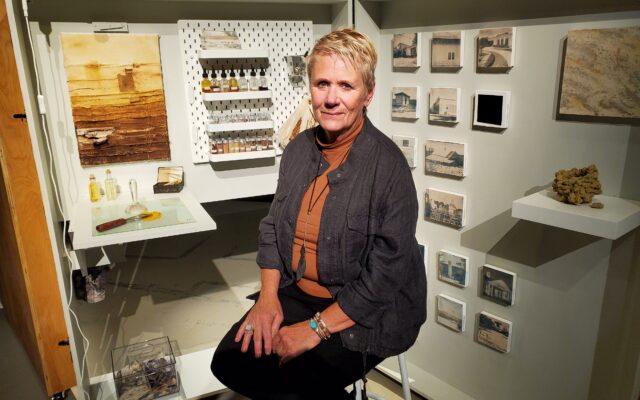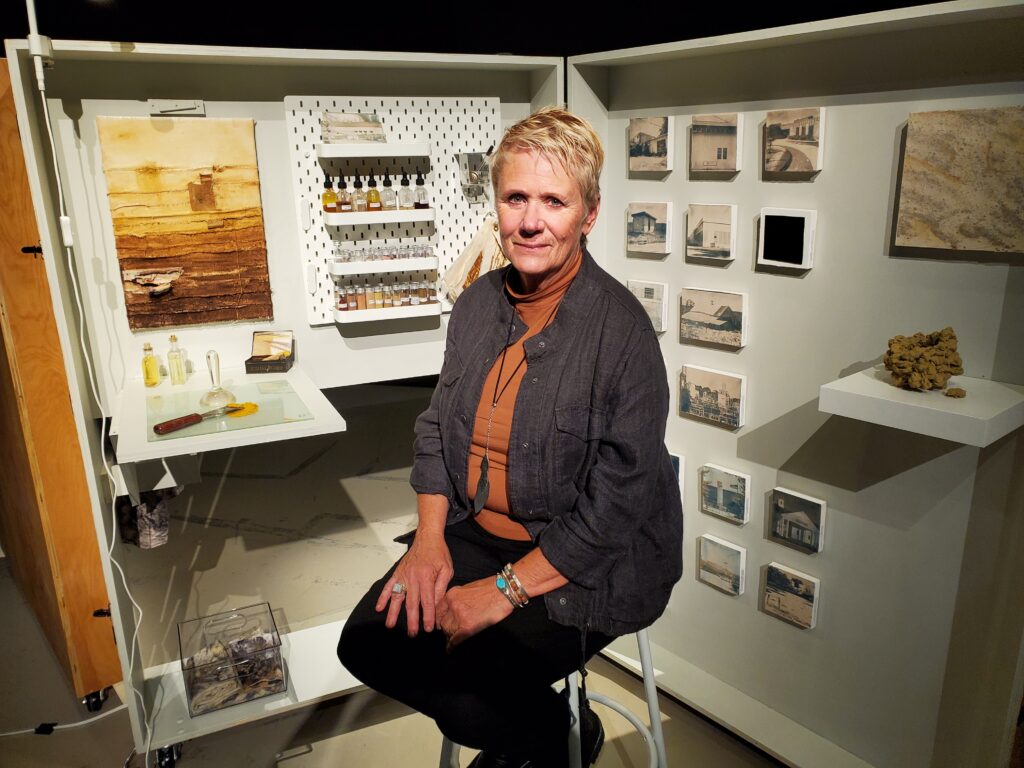
This Maine artist’s work is laden with PFAS — on purpose
By Emily Burnham, Bangor Daily News Staff
Not all that long ago, artist and University of Maine professor Susan Smith hadn’t heard the acronym that most Mainers are now all too familiar with: PFAS, also known as “forever chemicals,” the compounds that have contaminated soil and water across the country, and which have only garnered widespread public attention in recent years.
PFAS, used for decades in manufacturing, have been found in places ranging from farms to former military sites to elementary schools, and are linked to a raft of health problems, including cancer and pregnancy complications.
Always an environmentally minded artist and person, Smith looked at the tomatoes she grows each year in the garden at her home in Dover-Foxcroft, and wondered: could PFAS have contaminated them?

PFAS ART – UMaine artist and professor Susan Smith of Dover-Foxcroft, pictured in front of “Radical Gardening,” her ongoing project to highlight forever chemical contamination through her art.
“I’ve spent the past seven years making my artistic practice as sustainable and low- or no-impact on the environment as possible,” said Smith, who is also director of the Innovative Media Research and Commercialization Center at UMaine. “It almost seems as if that’s impossible now, with these chemicals seemingly everywhere.”
Over the past year, Smith embarked on a journey to highlight and understand the disturbing prevalence of “forever chemicals” through her art. She traveled to locations across the country with documented PFAS contamination, and collected soil, water and plant materials from them, in order to create pigments, paints, dyes and solutions to use to make art pieces like botanical prints, paintings, textile pieces and photographs.
The end result, “Radical Gardening,” is equal parts art installation and mobile laboratory, with art pieces, materials and other items contained within a folding wooden frame. Inside the frame are things like photo prints of sites Smith visited, developed using PFAS-contaminated water; skeins of yarn and fabric colored with PFAS-contaminated dye; and dried plants and flowers that grew in PFAS-laden soil, preserved in beeswax. It’s presently on display at the Innovative Media Research and Commercialization Center at UMaine through Saturday.
“Radical Gardening” is a delicately beautiful but sobering reminder of just how widespread PFAS contamination really is — and how little we know thus far about how to get rid of them.
“It’s so important to make all of this understandable to people, and to make tangible things that you can put in your hands and see with your eyes can really help to do that,” Smith said. “Art and science can be really powerful when they work together.”
So far, Smith has traveled as far as Virginia, Kentucky and Texas to collect samples of soil, water and plant life, including at the former site of the elementary school she attended while growing up outside of Houston. When processing those samples into paints or dyes, she wears gloves and a respirator, to avoid ingesting the chemicals.
In Maine, Smith collected samples from places like the former Brunswick Naval Air Station, a farm in Fairfield, and at Brooklin Elementary School, whose water has one of the highest known levels of PFAS contamination in the state for drinking water. She just last week collected samples from the Maine Air National Guard base at Bangor International Airport, where the Air Force has found high levels of PFAS in groundwater that may have spread beyond base property.
Smith’s artistic practice has increasingly dealt with social and political issues, most recently with a project for which she traveled to migrant detention centers along the U.S.-Mexico border and created art there that reflected the experiences of the people detained there. Her latest work with forever chemicals is part of that shift toward creating art with a social conscience.
“If I can say something with my work, I will,” she said. “I’ve traveled all over the country and seen the effects this pollution has had on people and the environment, and it’s heartbreaking.”
After its exhibition at the Innovative Media Research and Commercialization Center, “Radical Gardening” will go on display at the New York City Soil and Water Conservation District for the month of November. Smith will have an artistic residency there in the district’s Urban Soils Institute. She hopes to continue touring “Radical” to sites throughout the country, and to keep adding new pieces to it as she collects more and more PFAS-laden samples and creates art with it.
For more information on Susan Smith’s work, visit her Instagram page.